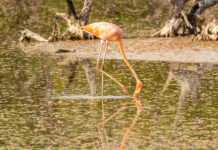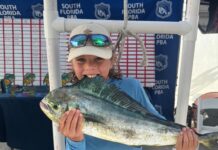I think my favorite Key West tree rat experience was years ago at Blue Heaven. Before they were as busy as they are these days, they used to put on plays in the back corner of the yard. This particular production was George Bernard Shaw’s “Saint Joan.” My friend Kathleen Balselmo was directing, and my friend Scott Elliott was starring as Saint Joan herself. (I think Richard Hatch was in the cast somewhere, but maybe I’m conflating it with the productions of “The Tempest” and “Peter Pan” they also did there.)
I’d helped a bit with some of the promotion for the show, and volunteered as an usher a few nights.
There was a battle scene in the play – a sword fight in which Joan of Arc is trying to lead her troops to defeat the enemy for the greater glory of France, as well as for assigned gender role defiers the world over – and every night during that scene, at the exact same point, a tree rat would make itself visible on the power line hanging over the stage, and run down it full speed, like a hero in an action movie. My wife got to see both the play and the rat, and for a long time afterward we’d be like, man, the tree rat was awesome.
Years, arguably decades, later I was lying half awake in our living room late one unseasonably cold February evening when I heard a kind of scratching at the one kitchen door we never used. I sat up and it stopped, so I lay back down and fell asleep again.
Minutes (hours?) later I heard kibble being crunched, not by the canines of our canine, but something that was taking much smaller, faster and more frantic bites. And when I sat up, I saw it – a tree rat sitting on top of the dog food bowl. I got up to chase it and the thing ran toward the wall and disappeared.
I moved the bowl away and behind it, in the base of the door, was a debris field of wood chips and a perfect Tom and Jerry mouse hole, maybe an inch wide and two inches high.
Up until that point, like most Key Westers I talked to, I had thought tree rats were these benign little creatures that, at worst, added comic relief to early-20th-century plays about how things could go horribly, horribly wrong even when people all thought they were doing the right thing. But now they had forcibly invaded our house. So I did a little reading.
The main thing I learned was that tree rats are just a lie we’ve been telling ourselves.
There’s no such thing as a tree rat. Or arguably, a tree rat is, at best, a euphemism for black rat, a.k.a. Rattus rattus if you want to get scientific and binomial about it, the world’s most basic garbage-munching rat.
Seeing a black rat run across someone’s yard and saying, “aw, look, a tree rat,” is just another one of Key West’s collective delusions (though my editor tells me she was on to their game years ago).
Black rats have a bit of a reputation. The go-to complaint against them is that they spread the bubonic plague around Europe a few times back in the day, though there’s an argument to be made that it was the Oriental Rat Fleas that actually carried the bacteria that caused the disease, and the rats just carried the fleas. But the black rat’s other zoonotic disease greatest hits include typhus, trichinosis, toxoplasmosis, and something rather charmingly plainspeakingly called rat-bite fever.
One species account I read about them referred to Homo sapiens as a Rattus rattus
“mutualist species,” but a mutualistic relationship between species implies a quid pro quo. We do a lot for them, but I’m not sure what they really do for us. Besides the infectious diseases, they are also known for destroying crops and food supplies – along with their cousins, the Norway rats – as well as chewing up the occasional bit of household wiring.
That being said, the fact that Rattus rattus is one of the more widely distributed species in the world – they are found on every continent – is pretty clearly the fault of humans. Black rats are thought to have evolved in Southeast Asia, but made their first foothold into Europe traveling the trade routes of the Roman Empire. There is some thought that their population collapsed when the Roman Empire fell apart, but had a resurgence during the Middle Ages when more stable trade routes were established. Once they made it to European port cities, they managed to invade the cargo holds of every ship that crossed an ocean, and distributed themselves around the world.
One article I read said Rattus rattus arrived in North America in the mid-1800s, but I couldn’t find the source for that information, and it seems likely they would have made their way onto the continent much earlier.
I got to thinking about the whole Rattus rattus thing the other day because our ice maker died. The previous owners of our house had kindly left us a binder full of manuals for all the kitchen appliances, air conditioners and whatnot, so I went leafing through it to see if I could find a manual with troubleshooting tips for the ice maker.
I did find the ice maker manual, and it turns out the ice maker was, in fact, dead. But I also found a yellowing eight-page flier from 1992 from the University of Florida, distributed by the Monroe County Extension Service, which was basically a guide to rats and mice you are likely to come across in Florida. It lists both house mice and Norway rats, but also something called roof rats. Which got me excited for a second. Because maybe it wasn’t Rattus rattus I was seeing all the time.
But even before I started Googling, I knew. Roof rat is just another name for black rat. As is ship rat, as is fruit rat, as is house rat.
After the dog bowl incident, It took a little while, but we managed to trap all the rats that had been making the raids. But we left the Tom and Jerry mouse hole. Because it looked kind of awesome. And also because if we covered it up, there’s a good chance that any rat that wanted to get into the house would just chew another hole.
I haven’t seen a rat make its way into our kitchen in years. But if I ever do see one again, at least I will know what to call it.






















